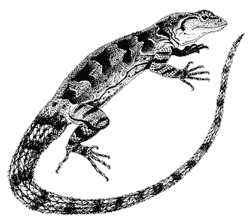Tree Lizard (Urosaurus ornatus)
Order: Squamata
Family: Iguanidae (iguanid lizards)
Spanish name: cachora, lagartija
Distinguishing Features
A small, up to 2½ inch (56 mm), black, dark brown, tan, or gray lizard, often with a rusty area at the base of the tail. The ground color of this slim-bodied lizard is broken with a dusky pattern of blotches and/or crossbars. There are two bands of enlarged scales down the middle of the back, separated by a strip of smaller scales. Adult males have bright blue or blue-green belly patches that have a metallic sheen. The color of the throat varies from yellow to green or blue-green. The throat of females can be white, orange, or yellow.

Range
This species occurs from southwestern Wyoming to southern Sinaloa and northern Coahila, Mexico, and from the Colorado River east to central Texas. It is found from sea level to 9000 feet (2770 m).
Habitat
This arboreal lizard most commonly lives in riparian zones in mesquite, alder and cottonwood, but it also is found on non-riparian oak, pine, and juniper. The tree lizard is also found on some non-native trees such as eucalyptus and tamarisk, and in some treeless areas; it is often very abundant on granite boulder piles. Color and pattern serve it well in avoiding detection by would-be predators.
Life History
The tree lizard eats insects and spiders. It reproduces 1 to 6 times per year, laying 2 to 13 eggs per clutch from March through August.
Comments
Secondary sexual traits, such as the brightly colored throat fold (dewlap) of the tree lizard, are often considered to play a part in mate selection (as well as in male-male competition). The theory is that females choose males based on physical or behavioral traits (dewlap color, body size, frequency of and intensity of social display or courtship) that they equate with “fitness” (superior reproductive success). Recent research on tree lizards, however, has failed to support this theory: female tree lizards did not seem to prefer one throat color over another, nor did they necessarily select the largest or most vigorous males. Instead, females may first select a suitable territory and then select a male whose range overlaps their territory.










